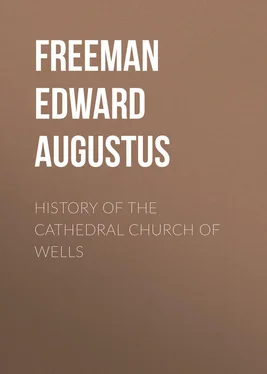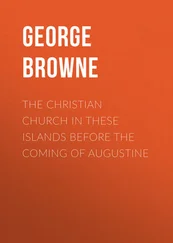Edward Freeman - History of the Cathedral Church of Wells
Здесь есть возможность читать онлайн «Edward Freeman - History of the Cathedral Church of Wells» — ознакомительный отрывок электронной книги совершенно бесплатно, а после прочтения отрывка купить полную версию. В некоторых случаях можно слушать аудио, скачать через торрент в формате fb2 и присутствует краткое содержание. Жанр: foreign_antique, foreign_prose, на английском языке. Описание произведения, (предисловие) а так же отзывы посетителей доступны на портале библиотеки ЛибКат.
- Название:History of the Cathedral Church of Wells
- Автор:
- Жанр:
- Год:неизвестен
- ISBN:нет данных
- Рейтинг книги:4 / 5. Голосов: 1
-
Избранное:Добавить в избранное
- Отзывы:
-
Ваша оценка:
- 80
- 1
- 2
- 3
- 4
- 5
History of the Cathedral Church of Wells: краткое содержание, описание и аннотация
Предлагаем к чтению аннотацию, описание, краткое содержание или предисловие (зависит от того, что написал сам автор книги «History of the Cathedral Church of Wells»). Если вы не нашли необходимую информацию о книге — напишите в комментариях, мы постараемся отыскать её.
History of the Cathedral Church of Wells — читать онлайн ознакомительный отрывок
Ниже представлен текст книги, разбитый по страницам. Система сохранения места последней прочитанной страницы, позволяет с удобством читать онлайн бесплатно книгу «History of the Cathedral Church of Wells», без необходимости каждый раз заново искать на чём Вы остановились. Поставьте закладку, и сможете в любой момент перейти на страницу, на которой закончили чтение.
Интервал:
Закладка:
Bishop Robert, having thus settled himself as Bishop of Bath and Wells, with two churches under his special care, began to set to work to put in order whatever needed reform in both of them. He enlarged and finished the church of Bath, if he did not actually rebuild it from the ground. I speak thus doubtingly, because our accounts do not exactly agree. The little book called "Historiola de Primordiis Episcopatûs Somersetensis" says that "he himself caused the church of the Blessed Peter the Apostle at Bath to be built at a great cost." 51 51 Historiola, p. 24: "Ipse ecclesiam Beati Petri Apostoli de Bathoniâ magnis c[=u] expensis construi fecit."
But the history commonly quoted as the Canon of Wells says only that "he finished the fabric of the church of Bath which had been begun by John of Tours." 52 52 Angl. Sacr. i. 561: "Complevit fabricam ecclesiæ Bathoniensis per Johannem Turonensem inchoatam." This seems to be confirmed by the words of John himself in the charter which I have already quoted (Monasticon, ii. 268), which is dated in 1116, and where he says that he sets aside the revenues of the city of Bath "ad perficiendum novum opus quod incepi."
Now the "Historiola" is the earlier authority, and that which we should generally believe rather than the other, whenever there is any difference between the two. But, on the other hand, stories generally grow greater and not smaller; a man's exploits are much more likely to be made too much of by those who repeat the tale than to be made too little of. When therefore the later writer attributes to Robert less than the earlier one does, one is tempted to think that the earlier writer exaggerated or spoke in a loose way, and that the Canon of Wells had some good reason for his correction. And this is the more to be noticed, because we shall find exactly the same difference when we come to the accounts which the two writers give of what Robert did at Wells. It is indeed said that the church and city of Bath were again destroyed by fire in 1135, and that this made Robert's rebuilding necessary. But the phrase of being destroyed by fire is often used very laxly of cases where a building, like York Minster within the memory of some people, was simply a good deal damaged, and had to be repaired, but did not need to be wholly rebuilt. At any rate, whether Robert altogether rebuilt or only finished, the great church of Saint Peter at Bath was now brought to perfection. Do not for a moment think that this is the Abbey Church of Bath which is now standing, and which I do not doubt that a great many of you know very well. The church of John and Robert was of course built in the Romanesque style with round arches, and in that particular variety of Romanesque which had been imported by Eadward the Confessor from Normandy into England, and which we therefore call the Norman style. But the present church of Bath is one of the latest examples of our latest English Gothic, and of that special variety of it which forms the local Perpendicular style of Somersetshire. Moreover the Romanesque church was very much larger than the present one, which covers the site of its nave only. One little bit of the Romanesque building, the arch between the south aisle and the south transept, is still to be seen at the present east end. The fact is that the later Bishops of Bath and Wells were not at all of the same mind as John of Tours. They lived much more at Wells than at Bath, and took much more care of the church of Wells. Bath indeed was quite neglected, and by the end of the fifteenth century the church was in a great state of decay. It was then, in the year 1500, that Bishop Oliver King and Prior Bird began to build the present church on a smaller scale and in a widely different style of architecture. Besides what he did to the church, Bishop Robert built or rebuilt all the conventual buildings of his Abbey of Bath, the cloister, refectory, dormitory, and the rest, all which were necessary for the monks of Bath, though the secular priests of Wells could do without them. 53 53 Historiola, p. 24: "Capitulum quoque et claustrum, dormitorium et refectorium et infirmatorium, nihilominus ædificari fecit."
Конец ознакомительного фрагмента.
Текст предоставлен ООО «ЛитРес».
Прочитайте эту книгу целиком, купив полную легальную версию на ЛитРес.
Безопасно оплатить книгу можно банковской картой Visa, MasterCard, Maestro, со счета мобильного телефона, с платежного терминала, в салоне МТС или Связной, через PayPal, WebMoney, Яндекс.Деньги, QIWI Кошелек, бонусными картами или другим удобным Вам способом.
1
"Domus eleemosynaria nobilis paupertatis" is the style of the Hospital of Saint Cross near Winchester, as enlarged by Cardinal Beaufort. See the Licence of Incorporation in the Monasticon, vii. 724.
2
I refer to the debate in the House of Commons on the Scotch Reform Bill of 1868, when it was discussed whether Wells or Evesham should be disfranchised.
"Sir Lawrence Palk argued on behalf of Wells that it is 'a cathedral city of great antiquity.' This appeal on behalf of the seculars was at once met by the monastic zeal of Sir John Pakington, who daringly answered, that if Evesham 'cannot boast of a cathedral, it can of one of the most beautiful abbeys in England.' We should be sorry to suspect the good town of Evesham of any Anabaptist tendencies, but it is certain that, if it makes the boast which the member for Droitwich puts into its mouth, it belongs to the class of those who do falsely boast … Mr. Gladstone had never been at Evesham; we know of no particular call of duty likely to take him there; but Sir John Pakington, a Worcestershire man, must surely have visited a borough in his own shire. How then about the beautiful abbey, one of the most beautiful in England? Any one who has been both at Wells and at Evesham must know that Wells Cathedral is still standing, while Evesham Abbey, saving its bell-tower and a small piece of wall, has long ceased to exist. But one might ask both disputants whether Sir Lawrence Palk, in his zeal for cathedrals, would enfranchise Ely and Saint David's – whether Sir John Pakington, in his zeal for abbeys, would restore Saint Alban's and enfranchise Romsey." — Saturday Review , July 11, 1868.
3
This Lecture was given in the time between the election and installation of the present Bishop, Lord Arthur Hervey.
4
In strictness the West-Saxon Bishoprick was first placed at Dorchester in Oxfordshire in 635, and the see was not finally settled at Winchester till 670. The time between these years was one of great confusion. See Bæda, Hist. Eccl. iii. 7. Florence of Worcester, i. 235. Stubbs, Registrum Sacrum Anglicanum, 161.
5
See Bæda, v. 18, and the Chronicle A.D. 709. The first Bishop at Sherborne was Ealdhelm. See his life by William of Malmesbury in Wharton, Anglia Sacra, ii. 20.
6
See Florence of Worcester, i. 236. Will. Malm. Gesta Regum, ii. 129. Gesta Pont. in Scriptores post Bædam, 144 b ; Canonicus Wellensis in Anglia Sacra, i. 554; Stubbs, 13.
7
In 710 Ine won a victory over the Cornish King Gerent; in 722 Taunton is spoken of as the town which Ine had built. This fixes the foundation of Taunton within that time. See the Chronicles under these years.
Читать дальшеИнтервал:
Закладка:
Похожие книги на «History of the Cathedral Church of Wells»
Представляем Вашему вниманию похожие книги на «History of the Cathedral Church of Wells» списком для выбора. Мы отобрали схожую по названию и смыслу литературу в надежде предоставить читателям больше вариантов отыскать новые, интересные, ещё непрочитанные произведения.
Обсуждение, отзывы о книге «History of the Cathedral Church of Wells» и просто собственные мнения читателей. Оставьте ваши комментарии, напишите, что Вы думаете о произведении, его смысле или главных героях. Укажите что конкретно понравилось, а что нет, и почему Вы так считаете.












